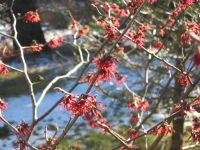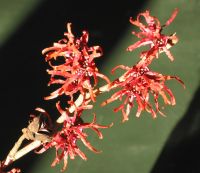Witch hazel Diane - Hamamelis x intermedia 'Diane'
English name:
Witch hazel Diane
Scientific name:
Hamamelis x intermedia Diane
Family:
Hamamelidaceae (Witch hazel family)
Height:
4 m.
Flowering:
January to March
Range:
cultivar from Arboretum Kalmthout, Belgium, 1969
 |
|
 |
 |
The 20 year old Hamamelis intermedia Diane in the picture was received as a grafted plant from Lønå Nursery, in Give. It can be found about 20 meters beyond the first grass plain and on the right had side of the main road, in square 1215 position 2125.
Plant description:
In one year the plant pictured above treated us with deep copper-red flowers in February and then followed up with golden-yellow flowers in the late autumn. How was this possible? Closer examination revealed that the Hamamelis intermedia Diane scion was grafted onto Hamamelis virginiana rootstock (a common practice). The Diane scion flowered in the autumn and then a large sucker from the rootstock gave us the yellow flowers late in the autumn. This sucker from the root stock has since been removed, because it was much more vigorous than the Diane scion and would have eventually ruined the plant.
We have 55 examples of the hybrid Hamamelis x intermedia in our collection in Hørsholm. Most are unnamed seed-plants, but we have several examples of the cultivar Nina and one example of the cultivar Diane. While in general not a strongly smelling as H. mollis 'Diane' produces a delightful perfume.
The Hamamelis x intermedia hybrid was first described in 1945 having shown up in the Arnold Arboretum. Similarly the hybrid was described in 1953 as Hamamelis x japollis from spontaneous hybridization between H. japonica and H. mollis at the Forest Botanic Garden in Charlottenlund (Lange 1953). One can see both names used, but because it was first, the official name is H. x intermedia. The cultivar Diane was named and described in 1969 by Robert and Jelene de Belder who for many years ran Arboretum Kalmthout in Belgium. It is just one of the many fine cultivars developed at there.
H. x intermedia are deciduous shrubs, often they are more vigorous than either of the parents. Diane however, is slow growing. This cultivar is reported to grow to 4 meters in height and is as wide high. Our specimen is only just approaching 2 m after 20 years. Leaves are alternate, and ovate (widest in the middle) to obovata widest nearer tip. In Diane the leaf margins are slightly wavy and they are narrowly heart-shaped at the base. The 4, strap-shaped petals are crinkled as in H. japonica but typically not so strait as in H . mollis. In Diane the 4 flower petals are a copper-red and the sepals deep purple. In contrast, the colour of the anthers is bright yellow. The woody fruit capsules hold two shinny-black seeds. A few seeds could still be seen on this plant in early February, but most have been shot out of the seed capsule by this time of the year. Diane also shows fine autumn colours with red and orange colours in the leaves most exposed to sunlight.
Although a bit expensive, Hamamelis x intermedia cultivars deserve to be used more frequently. They flower at a time of the year when one is still missing the sight and smell of flowers. They are especially wonderful when the sun is lower on the horizon but still illuminates the plants. The cultivar Diane featured here has been described as one of the finest red-flowered cultivars, but of course new cultivars are being developed all the time. The flowers are good for use in flower arrangements in the winter, especially when background wall colours do not show off the yellowed flowered types. Diane has received a gold medal from the Pennsylvania Horticultural Society and an Award of Merit from the Royal Horticultural Society of England. It is listed in the book Plants that Merit Attention.
If you want to gain a good impression of the potential of the Hamamelis genus, the Kalmthout Arboretum in Belgium holds a Hamamelis festival every year from the third Monday in January until the second Sunday in February.
References:
Bean, W.J. 1976 Trees and Shrubs Hardy in the British Isles Vol II. A-C. Bean and Murray publishers. 784 pp.
Houtmen, R. T. & van der Werf, W.J. 2002. Hamamelis sortimentsondersoek en keuringsrapport (A report from the assessment of varieties of Hamamelis). Dendroflora 39: 30-59.
Lange, J. 1953. Hamamelis japollis hybr. n. Dansk Dendrologisk Årsskrift 2:140-145.
Poor, J.M. & Brewster, N.P. 1996. Pp. 128. Plants that Merit Attention. Shrubs. Timber Press Publisher.
Rushforth, K. 1999. Trees of Britain and Europe. Harper Collins Publisher. 1336 Pp.
